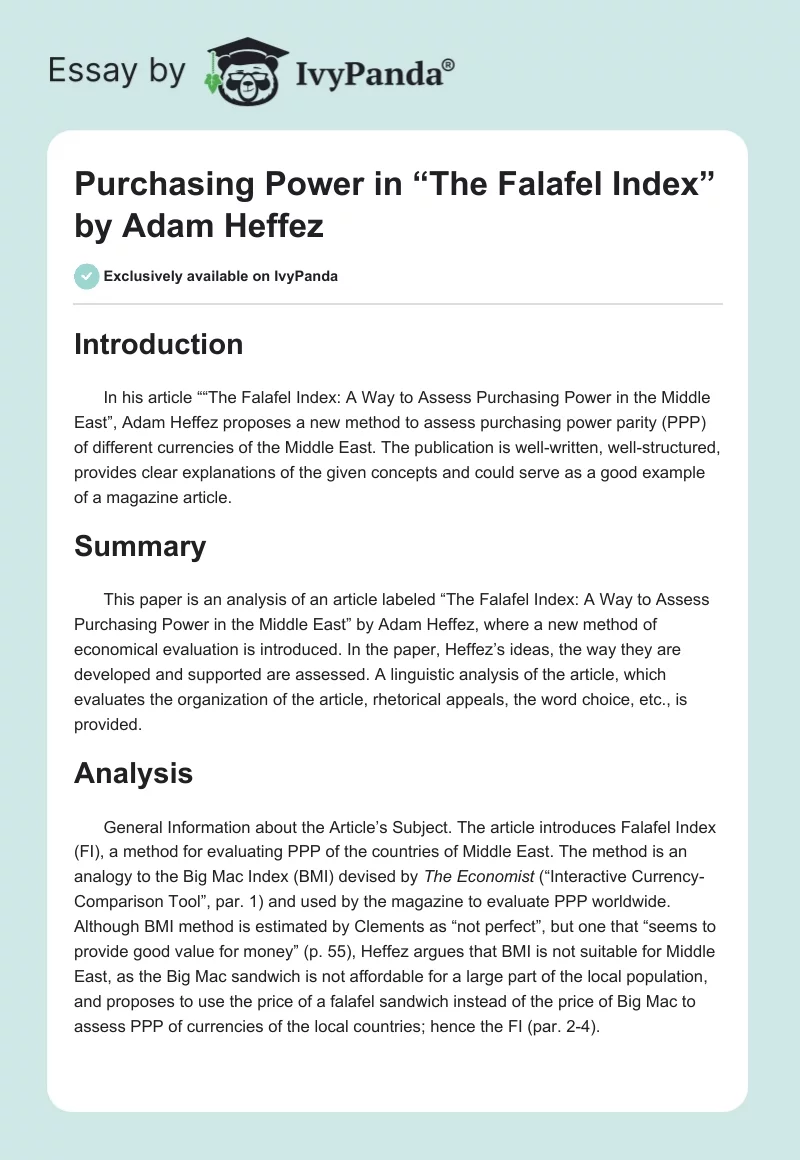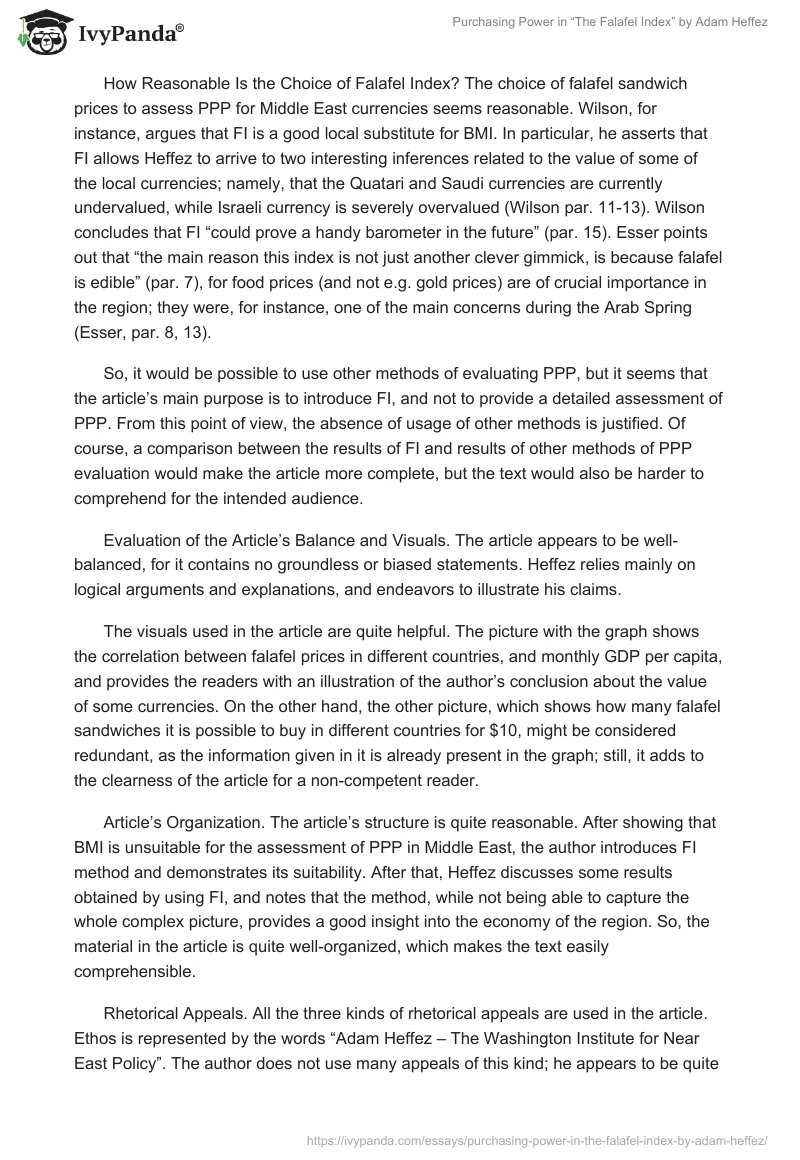Introduction
In his article ““The Falafel Index: A Way to Assess Purchasing Power in the Middle East”, Adam Heffez proposes a new method to assess purchasing power parity (PPP) of different currencies of the Middle East. The publication is well-written, well-structured, provides clear explanations of the given concepts and could serve as a good example of a magazine article.
Summary
This paper is an analysis of an article labeled “The Falafel Index: A Way to Assess Purchasing Power in the Middle East” by Adam Heffez, where a new method of economical evaluation is introduced. In the paper, Heffez’s ideas, the way they are developed and supported are assessed. A linguistic analysis of the article, which evaluates the organization of the article, rhetorical appeals, the word choice, etc., is provided.
Analysis
General Information about the Article’s Subject. The article introduces Falafel Index (FI), a method for evaluating PPP of the countries of Middle East. The method is an analogy to the Big Mac Index (BMI) devised by The Economist (“Interactive Currency-Comparison Tool”, par. 1) and used by the magazine to evaluate PPP worldwide. Although BMI method is estimated by Clements as “not perfect”, but one that “seems to provide good value for money” (p. 55), Heffez argues that BMI is not suitable for Middle East, as the Big Mac sandwich is not affordable for a large part of the local population, and proposes to use the price of a falafel sandwich instead of the price of Big Mac to assess PPP of currencies of the local countries; hence the FI (par. 2-4).
How Reasonable Is the Choice of Falafel Index? The choice of falafel sandwich prices to assess PPP for Middle East currencies seems reasonable. Wilson, for instance, argues that FI is a good local substitute for BMI. In particular, he asserts that FI allows Heffez to arrive to two interesting inferences related to the value of some of the local currencies; namely, that the Quatari and Saudi currencies are currently undervalued, while Israeli currency is severely overvalued (Wilson par. 11-13). Wilson concludes that FI “could prove a handy barometer in the future” (par. 15). Esser points out that “the main reason this index is not just another clever gimmick, is because falafel is edible” (par. 7), for food prices (and not e.g. gold prices) are of crucial importance in the region; they were, for instance, one of the main concerns during the Arab Spring (Esser, par. 8, 13).
So, it would be possible to use other methods of evaluating PPP, but it seems that the article’s main purpose is to introduce FI, and not to provide a detailed assessment of PPP. From this point of view, the absence of usage of other methods is justified. Of course, a comparison between the results of FI and results of other methods of PPP evaluation would make the article more complete, but the text would also be harder to comprehend for the intended audience.
Evaluation of the Article’s Balance and Visuals. The article appears to be well-balanced, for it contains no groundless or biased statements. Heffez relies mainly on logical arguments and explanations, and endeavors to illustrate his claims.
The visuals used in the article are quite helpful. The picture with the graph shows the correlation between falafel prices in different countries, and monthly GDP per capita, and provides the readers with an illustration of the author’s conclusion about the value of some currencies. On the other hand, the other picture, which shows how many falafel sandwiches it is possible to buy in different countries for $10, might be considered redundant, as the information given in it is already present in the graph; still, it adds to the clearness of the article for a non-competent reader.
Article’s Organization. The article’s structure is quite reasonable. After showing that BMI is unsuitable for the assessment of PPP in Middle East, the author introduces FI method and demonstrates its suitability. After that, Heffez discusses some results obtained by using FI, and notes that the method, while not being able to capture the whole complex picture, provides a good insight into the economy of the region. So, the material in the article is quite well-organized, which makes the text easily comprehensible.
Rhetorical Appeals. All the three kinds of rhetorical appeals are used in the article. Ethos is represented by the words “Adam Heffez – The Washington Institute for Near East Policy”. The author does not use many appeals of this kind; he appears to be quite an experienced researcher (“Adam Heffez. Professional Experience”), but limits himself to only mentioning his involvement with The Washington Institute. Pathos is used, but not much; a major emotional appeal is made when Heffez mentions the musical comedy named West Bank Story. The author seems to rely mainly on logos; he uses logical arguments while proving that BMI is unsuitable for the Near East, and while introducing FI and showing the results obtained by using it. Relying on logos seems to be a good choice for this type of article, as it introduces a method of assessment of PPP, an abstract notion used in economics.
Sources Used in the Article. Heffez does not refer to many sources in the text. He mentions The Majalla (Heffez par. 4), a popular magazine in Saudi Arabia (“Saudi Arabia – Marketing and Sales Strategy” par. 10) in which the notion of FI first appeared. But in this case the reliability appears to be not crucial, for the author only takes the notion of FI from the magazine and develops it on his own; he does not cite any information from the source. Heffez also refers to Numbeo (par. 10-11), “the world’s largest database of user contributed data about cities and countries worldwide” (Numbeo par. 1), which, being user-contributed, might not always be very reliable.
Stories Included in the Article. The author does not include many stories in his article, and the included ones are used primarily as illustrations. For instance, Heffez writes about the mentioned comedy West Bank Story to demonstrate that falafel is an important part of the local culture.
The Word Choice and Tone. The word choice appears to be suitable for the format of the article and its intended audience. The article is published in Forbes, a famous American business magazine, and not in a scientific journal. Consequently, the usage of scientific jargon would make the article incomprehensible for some of the potential readers. Therefore, Heffez chooses easier and less formal words, such as “pillowy”, “the big equalizer”, “falafelnomics” etc., but not overuses informality.
Gaps in the Article. The author doesn’t make any comparison between FI method and any other methods for identifying the PPP of currencies (except for BMI, which is proposed to be substituted by FI). If the article had been published in a scientific journal, this would undoubtedly be considered a gap; but, as we have already mentioned, for a magazine article the absence of such comparison appears appropriate.
Conclusion
Our analysis allows us to conclude that Heffez’s work has some drawbacks (such as the dearth of reliable references, the absence of comparison of FI to other methods of evaluating PPP, etc.), but otherwise it is a well-written article. Had it been a scientific publication, these drawbacks would be essential; but in a magazine article, they can be viewed as serving a purpose of making the article suitable for the audience.
Works Cited
Adam Heffez. Professional Experience. n.d. Web.
Clements, Kenneth W., Yihui Lan, and Shi Pei Seah. “The Big Mac Index Two Decades On: An Evaluation Of Burgernomics.” International Journal Of Finance & Economics 17.1 (2012): 31-60. Business Source Complete. Web.
Esser, Agaroth. The Falafel Economic Index: Not as Silly as You Think. 2014. Web.
Heffez, Adam. The Falafel Index: A Way To Assess Purchasing Power In The Middle East. 2014. Web.
Interactive Currency-Comparison Tool: The Big Mac Index. 2015. Web.
Numbeo. n.d. Web.
Saudi Arabia – Marketing and Sales Strategy. n.d. Web.
Wilson, Nigel. Can the Humble Falafel Sandwich Show When Middle East Economies Will Bite? 2014. Web.


